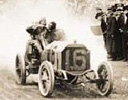RACER Magazine Stoops To Yellow Journalism
By
2/27/05
Photographs, particularly those used as accurate and trustworthy accounts of a significant event by respected publications, are our best hedge against the threat of devious editors and special interest groups who want to change truth and history. If the manipulation of photographs is accepted by any image, the public will naturally doubt all photographs and text within all publications.1
Dan Rather and The New York Times, meet RACER magazine. They are the newest members in the exceedingly not so exclusive club where journalistic integrity, facts, and impartiality are thrown out the window.
By now, many of you may already have heard of the fake photograph in the March 2005 issue of RACER. For those of you who have not, the photograph is a shot of a trio of IRL cars racing at Nazareth Speedway. The photo in RACER magazine has stands climbing seemingly to the heavens with fans packed in. The only problem is the original photo has sparsely filled stands with blue sky showing above the grandstands.
RACER felt it necessary to fake the photo by filling the stands up with a repeated section of the crowd and then in what could only be called as a rash of hubris, actually added rows upon rows to the grandstands. Thus, not only did they give the impression that the race was well attended, they actually faked how many people could even physically be at the race.
Needless to say, this caused quite a row on the message boards throughout the Internet. So much so, RACER magazine's Editor-in-Chief, Laurence Foster, felt compelled to issue a statement. A statement that was nothing short of laughable. First, he makes a joke about conspiracy theories, then admitted they "touched" up the photo, giving their reasons for it ("...used limited Photoshop cloning for aesthetic reasons, i.e., to fill up the frame..." and "Whether it’s cloning sky, crowds, asphalt or grass, it's a common and, in our opinion, not unethical technique when used purely for design reasons..."), and finally provided some lame examples of why there's nothing wrong with this ("In our Sebastien Bourdais piece in the same issue ... we've morphed two images into the lead spread, but that doesn't mean we're insinuating he's been cloned.").
As for the latter part of their statement, do they honestly believe their readers are idiots? There is a huge difference between an obvious photographic trick that everyone knows is a photographic trick versus faking a photo for "artistic" reasons which people may not know was altered, giving a wholly different story then what the original photo depicts. A story that can mislead sponsors among others.
As for those "artistic" reasons, this isn't about touching up a photo to fix the lighting or shadows, or removing blemishes from a Playboy model, or bringing out the color of scenery. Those are all techniques going back to the airbrushing days that everyone knows is being done. Granted, they do to a point distort the truth, but they do not distort the story of what the image is showing.
One would have thought that in today's day and age, RACER would have learned from the mistakes of others. The "to fill up the frame" is an interesting excuse. The only problem is, a major international magazine known for its famous photography and reputation for photojournalism excellence, was already taken to task for doing just that.
National Geographic ... yes, the National Geographic ... faked a photo of the pyramids for the February 1982 cover shot. In order to fit the shot within the confines of the portrait layout, they had to "move" the pyramids closer together. They never told their readers they had done this. People were incensed that they would falsely show the pyramids closer together than they actually are.
They too used the excuse that they were simply trying to "to fill up the frame." However, don't try telling that to Jack Corn, once director of photography for the Chicago Tribune who said such manipulation is "ethically, morally and journalistically horrible."2 In fact, Robert Gilka, a former director of photography at National Geographic before that incident said significantly manipulating images is "like limited nuclear warfare. There ain't none."3
The use of images to destroy the hedge against special interest groups has also been applied to television. However, when they were exposed, they too had to pay the piper. One such infamous case was the NBC Dateline story about GM pickup trucks exploding when hit on the side due to their side saddle tanks. In order to reproduce such an accident, NBC had a vehicle crash into the side of the pickup.
The only problem is, they laced the gas filler tube area with firecrackers and overfilled the tank, thus ensuring a spectacular "performance" for the cameras. This setup work was performed by a special interest group funded by a trail lawyers association who stood to profit greatly by this case, with full knowledge and approval of the NBC producers.
Needless to say, when GM caught wind of this, they had a major media conglomerate by the gonads. They didn't let go. In fact, they squeezed hard, and forced NBC to make a public admittance and apology. Whether the story was true or not, the manipulation of the images for "artistic" or "dramatic" reasons was not only wrong, but morally reprehensible.
Another case involves 60 Minutes and their investigation of the Jeep CJ-7 rollover problem. To film cases of the rollover, they added weight in odd locations, changed the tire pressures, and modified the remote mechanism to spin the steering wheel beyond it's normal capabilities. Even then, they didn't achieve a high percentage of rollovers, so CBS simply edited what they needed to show a film with constant rollovers. When Chrysler bought Jeep, they sued CBS and got an out of court settlement.
Every photographer I have heard from concerning the RACER magazine issue were shocked over this blatant manipulation. Two who I know personally were equally appalled by this, especially over the magazine's unwillingness to have stated the photo was retouched. Though they both say that there is always the battle of art directors wanting to touch up a photo and the photographer's unwillingness to allow them to do so, even to the point of losing the sale, they both agreed that they would never allow what RACER magazine did to any of their photos. And these two guys are no hacks. They have been hired by Car and Driver for assignments, and know full well the realities of the publishing industry.
I used to be a loyal subscriber to RACER magazine from the very first issue. A few years ago, I allowed my subscription to lapse. No particular reason at the time, and I always felt guilty for not resubscribing. Not anymore. I now know I can spend the money instead purchasing Weekly World News. After all, there is no difference.
Before computers were popular, the famous photojournalist, W. Eugene Smith said, "Let truth be the prejudice." Truth is the guiding principle—not layout efficiency, not magazine cover eye-catching ability, not political persuasion, but truth. When the truth is the prejudice, photographs, and the stories behind them, can be easily defended and are a source for humanistic concern and inspirations.4
NOTES
1— Paul Martin Lester, "Faking Images in Photojournalism," Media Development, January 1988, p. 41.
2— Sheila Reaves, "Digital Retouching," News Photographer, January 1987, p. 31.
3— Fred Ritchin, "Photography's New Bag of Tricks," The New York Times Magazine, November 4, 1984, p. 49.
4— Lester, p. 42.
Copyright © 2005 by Russell Jaslow and Deep Throttle. All Rights Reserved.
|




